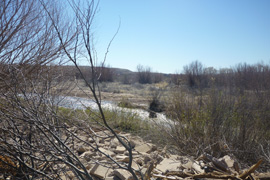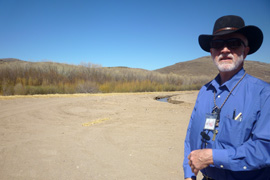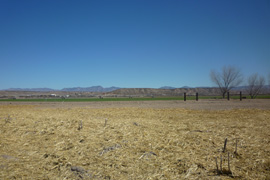Cronkite News has moved to a new home at cronkitenews.azpbs.org. Use this site to search archives from 2011 to May 2015. You can search the new site for current stories.
Rural communities criticize cuts to state water grant program
DUNCAN – The Gila River usually gurgles peacefully along Larry Barney’s ranch in eastern Arizona. In 2005, however, floodwaters breached a 10–foot–high levee and gushed over his fields, stripping away topsoil.
It wasn’t the first flood to harm his grazing land, but Barney hopes it will be the last.
He used a $745,000 state grant to remove the levees, smooth out the riverbanks and stabilize vegetation in hopes of preventing damage when the Gila floods.
“I was really quite enthused about doing it because I was ready to do anything,” Barney said. “I think the way it was going it was going to put me out of business.”
Now the program that made this project possible is in danger of fading away.
Last year, the Legislature cut a general fund appropriation that authorized up to $5 million annually to the Arizona Water Protection Fund. The program also receives fees from sales of surplus Central Arizona Project water, but those are a far cry from the state’s past support and at present aren’t enough to pay state employees who manage the grants.
“The one reason why the Arizona Water Protection Fund is so important is that these projects that really affect rural Arizona so much, they’re usually projects no one can afford to do,” said Jan Holder, executive director of the Gila Watershed Partnership, an alliance of residents and agencies that oversees water-improvement projects.
Since it was established in 1994, the fund has provided 209 grants.
Projects like the restoration on Barney’s ranch help landowners protect their livelihood by maintaining a balance with the river, said Phil Ronnerud, the Greenlee County engineer overseeing the project.
“Once we put up something in the floodplain, we can manage it, but we can’t control that water,” he said. “As soon as you put that up, Mother Nature will throw something at you greater than what you designed it for.”
Supporters of the fund want lawmakers to change the formula for paying the state workers who run the grant program. At present, only 5 percent of money deposited into the fund in a given calendar year can go toward administrative costs.
The fund is expected to take in only $103,000 in deposits this year, meaning only about $5,000 will be available to pay staff members who process reimbursements and offer new grants.
“The problem that we’re facing right now is the commission really can’t justify moving forward because we don’t have stable funding for staffing,” said Rodney Held, executive director of the Arizona Water Protection Fund Commission.
The program has value, he said, with projects ranging from restoring wetlands in Yuma to installing fences that keep livestock out of the Gila River to the Gila Watershed Conservation Project, which helps reduce water consumption.
Held said the fund’s advocates have struggled to garner legislative support for continuing the fund.
“They think we are just all about threatened and endangered species and that we’re environmentalists,” he said.
Sandy Bahr, director of the Sierra Club’s Grand Canyon Chapter, said the program’s impact on wildlife benefits the economy.
“We’re talking really high dollars,” she said. “It’s a huge part of the tourism industry in this state, and a lot of Arizonans engage in it.”
But Rep. Chester Crandell, R-Heber, vice chairman of the House Agriculture and Water Committee, said it all comes down to spending priorities.
“There’s basically only three areas, if you prioritize, that we should be putting most of our funding in: transportation, education and safety,” he said.
However, Crandell said the Joint Legislative Budget Committee is considering proposals to provide $300,000 requested by the Arizona Water Protection Fund Commission for administrative costs, though nothing is certain.
“There’s a lot of programs that people would like to have government-funded, but I’m not sure with the limited resources that we have that we’re going to be able to fund them all,” he said.
Holder, with the Gila Watershed Partnership, said water is getting even more precious as Arizona’s drought worsens. Rural communities depend on preserving it.
“This is good for Arizona, this is good for rural Arizona,” she said. “Water is important to us.”









